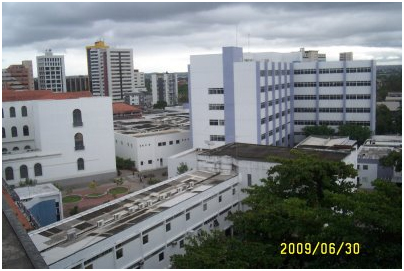
National Publications
The following publications used ISAAC data from Brasil:
- Solé D, Vanna AT, Yamada E, Rizzo MCV, Naspitz CK. International Study of Asthma and Allergies in Childhood (ISAAC) written questionnaire: Validation of the asthma component among Brazilian children. J Investig Allergol Clin Immunol 1998; 8(6): 376-382.
- Werneck G, Ruiz S, Hart R, White M, Romieu I. Prevalence of asthma and other childhood allergies in Brazilian schoolchildren. J Asthma.1999 Dec;36(8):677-90.
- Solé D, Yamada E, Vana AT, Werneck G, Solano de Freitas L, Sologuren MJ, Britto M, Rosário Filho NA, Stein RT, Mallol J. International Study of Asthma and Allergies in Childhood (ISAAC): prevalence of asthma and asthma-related symptoms among Brazilian schoolchildren. J Investig Allergol Clin Immunol 2001; 11(2): 123-8.
- Solé D, Camelo-Nunes IC, Vana AT, Yamada E, Werneck F, de Freitas LS, Sologuren MJ, Britto M, Rosário Filho NA, Stein RT, Naspitz CK. Prevalence of rhinitis and related-symptoms in schoolchildren from different cities in Brazil. Allergol Immunopathol (Madr). 2004 Jan-Feb;32(1):7-12.
- Solé D, Camelo-Nunes IC, Wandalsen GF, Sarinho E, Sarinho S, Britto M, Rosário NA, de Freitas Souza LS, Stein R, Fischer GB, Naspitz CK. Ecological correlation among prevalence of asthma symptoms, rhinoconjunctivitis and atopic eczema with notifications of tuberculosis and measles in the Brazilian population. Pediatr Allergy Immunol.2005 Nov;16(7):582-6.
- Solé D, Camelo-Nunes IC, Wandalsen GF, Mallozi MC, Naspitz CK, for members of the Brazilian ISAAC Group. Prevalence of atopic eczema and related symptoms in Brazilian schoolchildren: results from the International Study of Asthma and Allergies in Childhood (ISAAC) Phase 3. J Investig Allergol Clin Immunol 2006; 16(6): 367-76.
- Solé D, Wandalsen GF, Camelo-Nunes IC, Naspitz CK, Naspitz CK, Brazilian ISAAC's Group. Prevalence of symptoms of asthma, rhinitis, and atopic eczema among Brazilian children and adolescents identified by the International Study of Asthma and Allergies in Childhood (ISAAC) - Phase 3. J Pediatr (Rio J) 2006; 82(5): 341-6.
- Solé D, Camelo-Nunes IC, Wandalsen GF, Pastorino AC, Jacob CMA, González C, Wandalsen NF, Rosário Filho NA, Fischer GB, Naspitz CK. Prevalence of symptoms of asthma, rhinitis, and atopic eczema in Brazilian adolescents related to exposure to gaseous air pollutants and socioeconomic status. J Investig Allergol Clin Immunol 2007; 17(1): 6-13.
- Solé D, Cassol VE, Silva AR, Teche SP, Rizzato TM, Bandim LC, Sarinho ES, Camelo-Nunes IC. Prevalence of symptoms of asthma, rhinitis, and atopic eczema among adolescents living in urban and rural areas in different regions of Brazil. Allergol Immunopathol (Madr). 2007 Nov-Dec;35(6):248-53.
- Pereira MU, Sly PD, Pitrez PM, Jones MH, Escouto D, Dias AC, Weiland SK, Stein RT. Non-atopic asthma is associated with helminth infections and bronchiolitis in poor children. Eur Respir J 2007; 29:1154-1160.
- Solé D, Melo KC, Camelo-Nunes IC, Freitas LS, Britto M, Rosário NA, Jones M, Fischer GB, Naspitz CK. Changes in the prevalence of asthma and allergic diseases among Brazilian schoolchildren (13-14 years old): comparison between ISAAC Phases One and Three. J Trop Pediatr.2007 Feb;53(1):13-21.Epub Sep 2006.
- Solé D, Camelo-Nunes IC, Wandalsen GF, Rosário Filho NA, Naspitz CK, Brazilian ISAAC's Group. Prevalence of rhinitis among Brazilian schoolchildren: ISAAC phase 3 results. Rhinology.2007 Jun;45(2):122-8.
- Solé D, Camelo-Nunes IC, Wandalsen GF, Mallozi MC, Naspitz CK, Brazilian ISAAC's Group. Is the prevalence of asthma and related symptoms among Brazilian children related to socioeconomic status?. J Asthma.45(1):19-25, 2008 Jan-Feb.
Brasil, Latin America
| Centres: | Phase: | PI: | Age Groups |
|---|---|---|---|
| Curitiba | 1 | Professor Nelson Rosário | 13-14 |
| Porto Alegre | 1 | Professor Renato Stein | 13-14, 6-7 |
| Recife | 1 | Dr Patricia Gomes M Bezerra | 13-14, 6-7 |
| Salvador | 1 | Associate Professor Leda de Freitas Souza | 13-14 |
| São Paulo | 1 | Professor Dirceu Solé | 13-14, 6-7 |
| Uruguaiana | 2 | Professor Renato Stein | |
| Aracaju | 3 | Dr Jackeline Machado Motta Franco | 13-14, 6-7 |
| Belo Horizonte | 3 | Associate Professor Paulo Augusto M Camargos | 13-14 |
| Brasília | 3 | Dr Wellington G Borges | 13-14 |
| Caruaru | 3 | Assistant Professor Almerinda Silva | 13-14 |
| Curitiba | 3 | Professor Nelson Rosário | 13-14 |
| Feira de Santana | 3 | Associate Professor Leda de Freitas Souza | 13-14, 6-7 |
| Itajaí | 3 | Dr Cláudia dos Santos Dutra Bernhardt | 13-14, 6-7 |
| Maceió | 3 | Professor Francisco José Passos | 13-14, 6-7 |
| Manaus Amazonas | 3 | Dra Maria do Socorro Cardoso | 13-14, 6-7 |
| Nova Iguaçu | 3 | Associate Professor Antônio José Ledo Aves Cunha | 13-14, 6-7 |
| Passo Fundo | 3 | Dr Arnaldo C Porto Neto | 13-14 |
| Porto Alegre | 3 | Dr Gilberto B Fischer | 13-14 |
| Recife | 3 | Dr Murilo de Britto | 13-14 |
| Rural Santa Maria | 3 | Professor Dirceu Solé | 13-14 |
| Salvador | 3 | Associate Professor Leda de Freitas Souza | 13-14, 6-7 |
| Santa Maria | 3 | Professor Dirceu Solé | 13-14 |
| Santo Andre | 3 | Associate Professor Neusa Wandalsen | 13-14, 6-7 |
| São Paulo | 3 | Professor Dirceu Solé | 13-14, 6-7 |
| São Paulo West | 3 | Dr Antonio Carlos Pastorino | 13-14, 6-7 |
| Vitória da Conquista | 3 | Associate Professor Leda de Freitas Souza | 13-14, 6-7 |
National Coordinator:
Roles:
- National Coordinator for Brasil
- Phase One Principal Investigator for São Paulo
- Phase Three Principal Investigator for Rural Santa Maria, Santa Maria, São Paulo
Professor Dirceu Solé
Professor of Allergy, Clinical Immunology and Rheumatology
Dept of Pediatrics
Federal University of São Paulo-Escola Paulista de Medicina
São Paulo
Brasil
ISAAC in Brazil
The International Study of Asthma and Allergies in Childhood (ISAAC) in Brazil was a real watershed of our knowledge about the true prevalence of asthma and allergic diseases in the country.
Prior to this study, the Brazilian epidemiologic data were restricted to small population samples, mostly from large urban centers and educational institutions, and without any standardization that would allow the comparison between the data obtained. In 1996, for the first time, reliable epidemiological data were obtained in seven major Brazilian centers, when it was possible to verify the heterogeneity of asthma and allergic diseases in our environment.
Once consolidated for use in the Brazilian population, the ISAAC protocol has been used by other national groups and has further expanded the knowledge about the prevalence of asthma in the entire national territory.
In phase 3, the number of participant centers was significantly higher and it was possible to obtain a map of the distribution of asthma and allergic diseases in the country. These data made it possible to better inform public health systems and that their participation was more effective in controlling asthma and allergic diseases. The use of the complementary questionnaire in part of the population studied enabled the identification of risk factors and/or protection associated with asthma in the adolescent population. Regional differences were more evident taking into account that Brazil is a country with continental dimensions and that besides the native Indian population, has received the most diverse ethnic groups around the world, which resulted in high degree of miscegenation.



